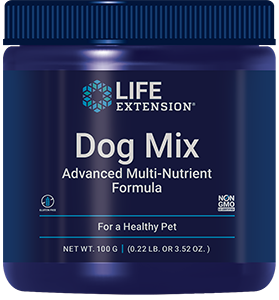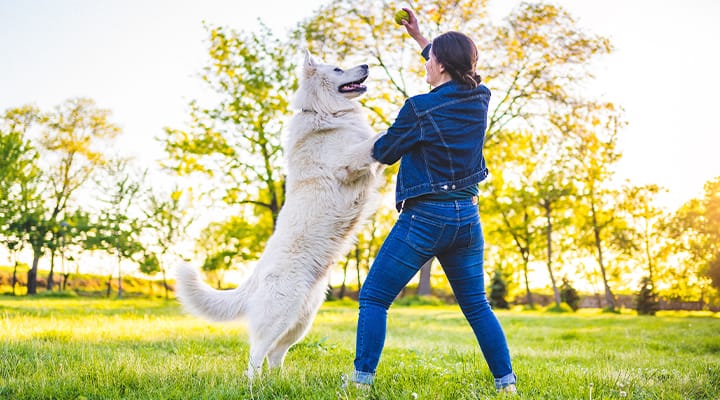
11 Ways to Improve Your Dog's Kibble
Published: April 2024
Have you ever looked at your dog's dry food bowl and thought, "how can I make his meals more exciting?" As pet parents, we're always looking for ways to perk up their lives—from switching up exercise routines to adding flavor to our dog's diet. You may worry they don't love the boring commercial food, or something is missing, so you want to experiment with their kibble. Cue in food additives. Yes, exactly what it sounds like: things you add to your dog's daily meals.
Now, that does not mean tossing in heavy, calorie-laden toppings or junk food; it's about contributing to your dog's nutrition, not detracting from it. And fortunately, we have many easy, healthy ideas—11 to be exact! These food additives will enrich your dog's nutrition and add plenty of variety to their daily meals.
What are dog food additives?
Are you balking a bit at the idea of an additive being a good thing? The word "food additives" means something very different in human food parlance than it does among the pet set. When we're talking about food additives in human food, we're usually referring to artificial coloring, sweeteners, and flavors, which are not the best nutritional choices.
In contrast, food toppers or additives for dogs are actual types of food (most of which we eat ourselves) ranging from eggs to fish. No Red Dye No. 5 here! Topping the food bowl with these additives is an excellent way to enrich your dog's meals and support several aspects of their health, including their joints, skin and fur, digestion and head-to-tail health.
That being said, if you do opt to use food additives, be sure to consult your veterinarian first. They will help you choose the best additives and the right amount for your dog to avoid unbalancing their diet.
Pro tip: Food additives shouldn't exceed 10% of the total calories they consume.
11 dog food additives to help boost your dog’s diet
So, what counts as an additive for dogs? Think sardines for protein and fatty acids, or fruits for antioxidants, yogurt for probiotics and calming soft chews with L-theanine to help them manage those not-so-brave moments.
Here are 11 ways you can introduce new flavor and texture to your pooch's palate.
1. Eggs
Well-known for their protein content, eggs are potentially the easiest way to crack the kibble code. Like humans, dogs can eat eggs that are scrambled, soft or hard-boiled. You can also crack a raw egg into your dog's food (shells and all) as a source of added protein and other nutrients like calcium, B vitamins, vitamin D, selenium and more.
2. Raw meats and organs
Certified Canine Nutritionist Kayla Kowalski has another kibble-topping, protein-rich hack in her custom recipes. Mix in any kind of meat—chicken, turkey, lean beef or venison—either ground or in pieces small enough to prevent choking, served raw or lightly cooked. You can also add organ meats like liver, heart and kidney to complement the vitamins and minerals in your dog's diet.
3. Fish
While canned sardines packed in water (not oil) top our list of fish toppings, jack mackerel and pink salmon are also great food additive choices, because they are packed with beneficial fatty acids and trace minerals like phosphorus, iron, zinc, magnesium and more.
4. Cooked or pureed veggies
When it comes to giving your cuddle muffin a daily diet boost, the saying "eat your vegetables!" surely applies. From cucumbers, broccoli, celery and zucchini to carrots, turnips, Brussels sprouts, and asparagus—and lots of vegetable garden varieties are welcome!
Unlike humans, however, dogs don't chew their food enough to break down raw veggie cell walls and get all that nutritional goodness. For your dog to best digest and reap the benefits of their vegetables, be sure to cook, puree, juice or blend them. But before you give your dog vegetables, be sure to confirm it's safe (a quick Google search can suffice). Some vegetables like onions, garlic, chives and shallots negatively impact your cuddle muffin's health. Also, avoid serving veggies from the nightshade plant family—potatoes, tomatoes, peppers, and eggplant.
5. Plain yogurt or kefir
Fermented dairy products that are homemade or contain added probiotics can boost your best friend's breakfast, lunch and dinner. Whole-milk yogurt or kefir is fine (unless your pup is on a low-fat diet). Just be sure to avoid products with xylitol (more on that later!).
6. Canned pumpkin puree
Pumpkin is pure magic when it comes to your dog's digestion—it helps promote digestive comfort and function. Give pureed pumpkin to your pet in small amounts, making sure the product you've chosen is plain and pure (not pumpkin pie!).
7. Canned sweet potato puree
Sweet potatoes are the superheroes of root vegetables. While they're rich in vitamin A—which promotes healthy skin, coat, eyes, nerves, and muscles—they're also great sources of vitamins C, B6, calcium and iron. A little scoop of this good stuff will go a long way; just choose canned sweet potatoes that are unsweetened.
8. Berries
Strawberries, raspberries, blueberries, blackberries—they're all chock full of antioxidants. These fruits, considered by many to be "superfoods," make a great addition to your dog's dish. Toss in a handful of fresh or frozen berries to give your dog a sweet treat and help support immune system function.
9. Dietary supplements
Another way to mix in some texture and taste while supporting your dog's diet is by finishing the feast with chewy supplements. Choose high quality supplements to support hip and joints health, a healthy skin and coat and more—it's an excellent way to customize their meals.
10. Spirulina
While blue-green algae might not seem like the most likely pet food supplement, Kowalski also serves up spirulina in her dog-friendly meal plans. And it's no wonder why: this highly nutritious microalgae has a wide range of health benefits and comes in multiple, easy-to-use forms.
11. Coconut oil
Drizzle drops of coconut oil on your pooch's plate for a tasty nutritional boost. Coconut oil consists of medium-chain triglycerides (MCTs)—and these good fats are an excellent source of fuel and energy. Not only that, but coconut oil has been known to help support the condition of your dog's skin and coat.
What ingredients should I avoid in dog food?
Food additives are an excellent way to keep your best friend in tip-top health. As you prep your pet's new menu, though, it's important to pay close attention to the ingredients contained in each food additive, and the type of container you use to dish out the deliciousness (avoid melamine bowls).
You'll want to steer clear of foods known to be unsafe for dogs, including:
- Chocolate
- Garlic
- Onions and leeks
- Grapes and raisins
- Avocado
In addition, handle all raw foods carefully, keeping your eye on expiration dates and giving raw meats a good sniff before serving. Read all labels carefully—choose food additives without dyes, artificial flavors, corn syrup, meat meal, unhealthy fats, and the sugar alternative Xylitol—that one is an absolute no-no for pets!
While store-bought pet food often contains some preservatives to prevent spoilage, you'll want to avoid unnecessary nitrates, MSG, sodium, BHA, BHT and other preservatives. And always consult your veterinarian before starting your dog's exciting new meal plan.
With these caveats aside, thinking outside the dog food box is a great way to help your dog live their healthiest life and to and make sure they get the vitamins and minerals they need. Whether you feed your pooch dry food or canned wet food, commercial dog food is formulated to meet their specific needs at every stage and age, providing them with high quality nutrition and the right amount of calories. But if you want to give your dog's meals an extra "oomph" in texture and nutritional benefits, food additives are an excellent way to do it.
About the Author: Brooke L. Diaz has written for some of the world’s most notable brands—including Aveda, Macy’s, Gap and Chopra Global. She is certified in youth coaching and meditation and teaches strength, movement, and mindfulness to elementary-age children with her small business, Camp Vitamin C™. She’s also a dedicated mother of two.
Website: www.CampVitaminC.com
References
- "Additives." European Pet Food. https://europeanpetfood.org/pet-food-facts/fact-sheets/nutrition/additives/
- "Ingredients to Avoid in Dog Food, Treats, and Bones." Union Lake Veterinary Hospital. March 2022. https://unionlakeveterinaryhospital.com/blog/ingredients-to-avoid-in-dog-food-treats-and-bones
Like what you read?
Please subscribe to get email updates on this blog.










